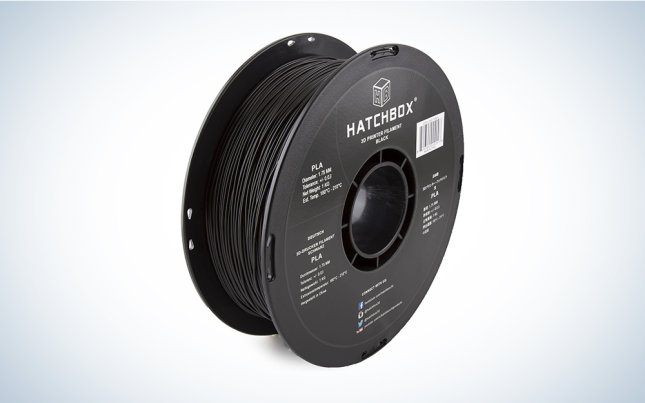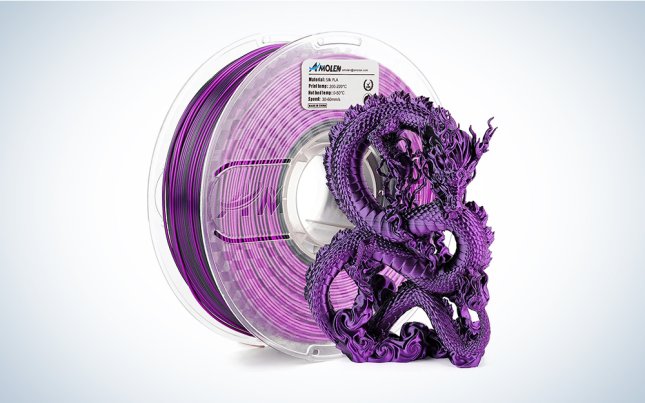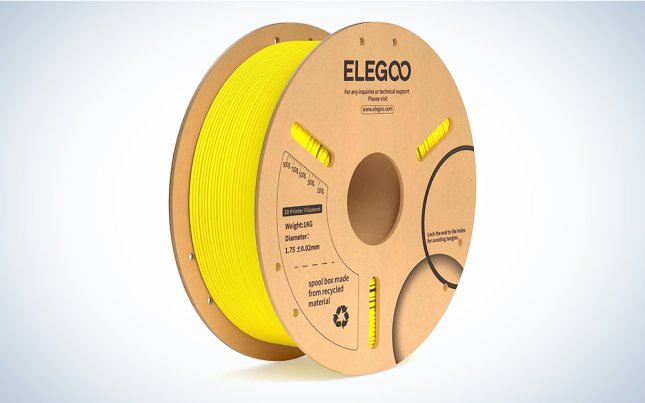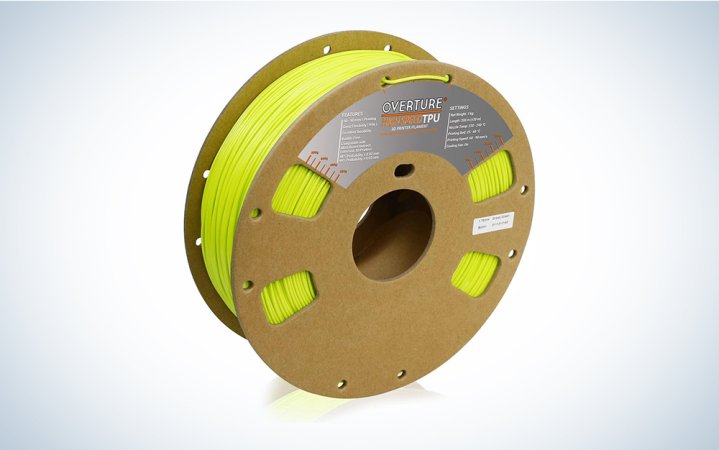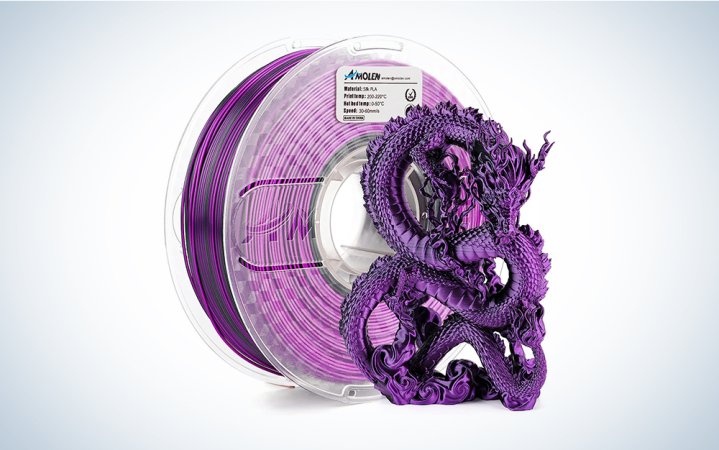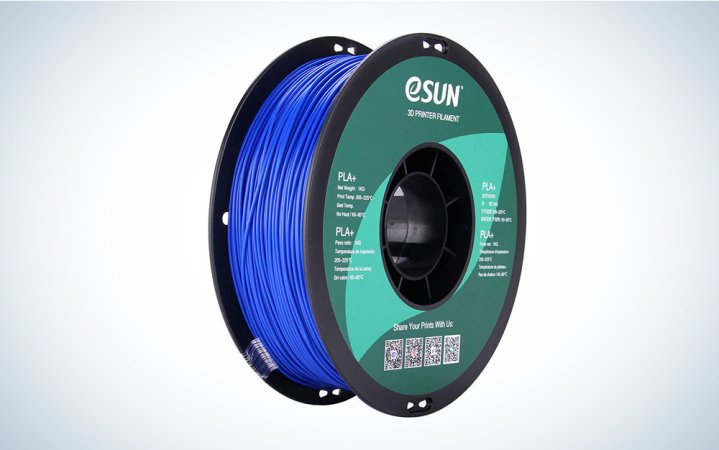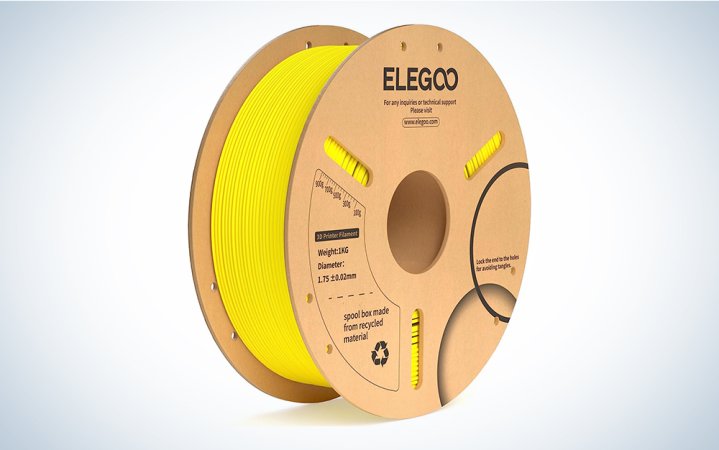We may earn revenue from the products available on this page and participate in affiliate programs. Learn more ›
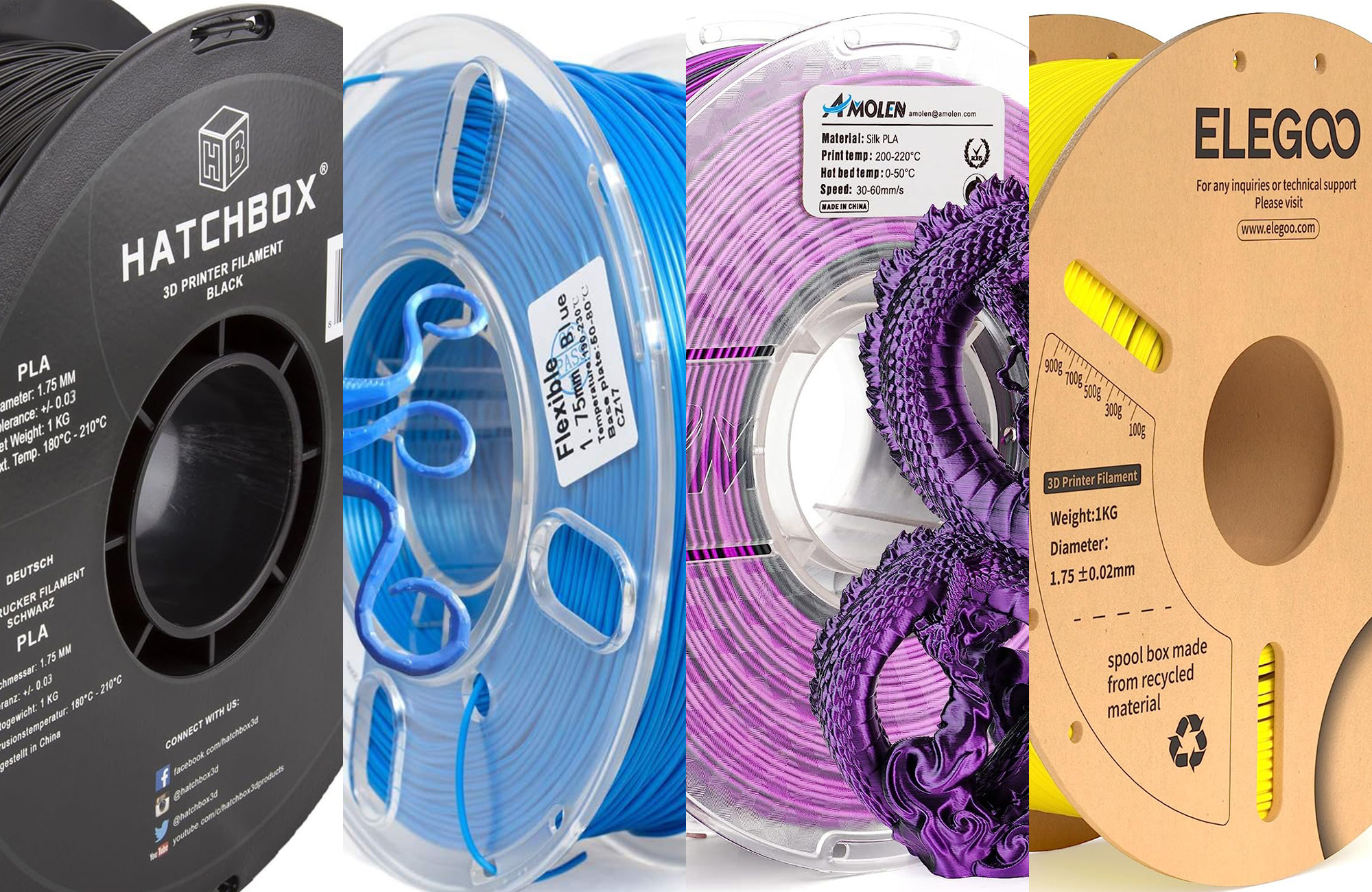
If you’re interested in 3D printing, you’ll need 3D printer filament. 3D printing is a colorful, creative way to make cosplay items, little doohickeys like glasses holders and fidget spinners, and even vacuum cleaner adapters. If you can dream it up, it’s most likely able to be 3D printed. However, not all 3D printer filament is made alike, and picking the wrong one for your project can lead to frustration, disappointment, and a wonky half-realized object you’ll need to scrap. The best 3D printer filaments are equal parts tough, easy to use, and able to yield great results.
- Best overall: HATCHBOX 1.75mm Black PLA 3D Printer Filament
- Best for strength: PRILINE TPU 3D Printer Filament
- Best flexible: OVERTURE TPU Filament 1.75mm Flexible TPU Roll
- Best for beginners: AMOLEN PLA 3D Printer Filament
- Best for miniatures: eSUN PLA PRO (PLA+) 3D Printer Filament
- Best budget: ELEGOO PLA+ Filament
How we chose the best 3D printer filaments
We considered material, diameter, color options, and recommended printing temperatures in judging the best 3D printer filaments. Since 3D printer filament isn’t crazy cheap, we made sure to pick options that yield consistent results, meaning fewer projects to scrap. Additionally, we looked at reviews and recommendations and tested them ourselves—shout out to Corey Foster, resident craft man, Cricut king, and director of commerce account management at Recurrent Ventures, for his help with testing and recommendations.
The best 3D printer filaments: Reviews & Recommendations
3D printer filament, like the best 3D printers, can give you a creative outlet and a feeling of accomplishment as you turn imagination into tangible objects. One of our picks should level up your costume or home decor.
Best overall: HATCHBOX 1.75mm Black PLA 3D Printer Filament
Pros
- Beginner- and expert-friendly
- Good layer adhesion
- Less likely to warp
Cons
- Has a tendency to tangle on the spool
Specs
- Diameter: 1.75 mm
- Material: PLA
- Color options: 30
- Recommended printing temperature: 356-410°F
If you’re looking for fewer temperature, consistency, and adhesion issues, look no further than this PLA filament from Hatchbox. It comes in a 1.75-millimeter diameter and has lots of color options. Additionally, we love its temperature, speed ranges, and practically odorless printing and recyclability. There’s also minimal warping and no heating bed required. Hatchbox impressed us with its quality, materials, colors, and reliability, and we’re sure you’ll be impressed too. However, some reviews note that it tends to tangle on the spool—although you might not need to completely re-spool it, you should try some preventative measures.
Best for strength: PRILINE TPU 3D Printer Filament
Pros
- Flexible and strong
- Easy to print
- Great print quality
Cons
- Has to be printed at a lower speed
- Hot base plate required
Specs
- Diameter: 1.75 millimeter
- Material: TPU
- Color options: 14
- Recommended printing temperature: 374-410°F
If your projects need to be strong but not stiff, look to this TPU filament. Although it has to be printed at a lower speed and a hot base plate is required, it prints fantastically and yields great results. Don’t take our word for it: One reviewer notes, “The print quality is almost indistinguishable from similar prints in PETG, and I’m starting to use it in place of materials like PC, PETG, and ABS in places where I need mechanical strength with a little bit of give instead of potential cracking or [delamination].”
Best flexible: OVERTURE TPU Filament 1.75mm Flexible TPU Roll
Pros
- Comes in a vacuum-sealed foil bag
- Can print faster compared to other TPU filament
- Yields great results
Cons
- Tough to get prints off the bed
- Soft and prone to clogging
Specs
- Diameter: 1.75 mm
- Material: TPU
- Color options: 21
- Recommended printing temperature: 410-446°F
Moisture is 3D printer filament’s worst enemy. This spool comes in a vacuum-sealed foil bag, meaning it’s almost guaranteed to come to your house as fresh as can be. It has a great balance of flexibility and durability and is consistent when it comes to project quality. Some reviews note that the prints get stuck to the bed—use a glue layer or heat the bed to 104°F as a preventative measure. You can print it faster than other TPU filaments; it’s also soft, meaning it might clog your machine if the printer speed is too high.
Best for beginners: AMOLEN PLA 3D Printer Filament
Pros
- Comes in a resealable bag
- Less prone to bubbling, clogging, and tangling
- Interesting colors
Cons
- Takes a long time to seal a bag
Specs
- Diameter: 1.75 mm
- Material: PLA
- Color options: 21
- Recommended printing temperature: 392-428°F
If you’re getting into 3D printing to create pieces for a cosplay or just for fun, this filament mixes quality and ease of use. Additionally, we love the fun, color-shifting filament that jazzes any project. And, you don’t have to purchase additional measures to keep moisture at bay with an included resealable bag. The filament also is less prone to bubbling, clogging, and tangling. It is a little expensive, but considering the reliability and lifespan, we think it’s worth paying. It’s shiny and silky, and you wouldn’t even know you 3D printed a project unless you pointed it out. Combine it with the best 3D printers for beginners to start your 3D-printed journey.
Best for miniatures: eSUN PLA PRO (PLA+) 3D Printer Filament
Pros
- Rigid
- Vacuum-packed
- Good adhesion
Cons
- Needs to dry before using
Specs
- Diameter: 1.75 millimeters
- Material: PLA+
- Color options: 22
- Recommended printing temperature: 401-437°F
Tiny projects require great precision. The eSUN PLA PRO (PLA+) 3D Printer Filament is stronger than PLA and is strong—no brittleness issues here. It also extrudes evenly and adheres to itself. The spools come vacuum-packaged, so you’re guaranteed a fresh roll. The filament also comes out thin and glossy, and miniatures are detailed and smooth. It does need to dry before use, but it yields a quality print once it does. Also, reviews note that the filament performs best with a hotter plate (around 176°F) and a higher temperature.
Best budget: ELEGOO PLA+ Filament
Pros
- Consistently the same diameter down the spool
- Odorless printing
- Smooth extrusion
Cons
- Colors not vibrant
Specs
- Diameter: 1.75 mm
- Material: PLA+
- Color options: 13
- Recommended printing temperature: 401-446°F
Clocking in at $15, this filament won’t run your wallet dry if you’re looking to expand your color library. Don’t be fooled by its price. Not only is its diameter consistent down the entire roll, it’s eco-friendly, is less likely to warp and shrink, and is odorless when printing. It’s tough, relatively bubble-free, and extrudes smoothly. You can even recycle the wooden spool it comes on. However, the colors aren’t as vibrant and opaque compared to their more expensive counterparts.
What to consider when buying the best 3D printer filaments
Using one colored pencil to draw gets boring after a while, and you may need a different color to make a project shine. The same goes for 3D printer filament—sure, you could stick with one spool in one color, but just imagine what you can do with different spools of varying strength, materials, and diameters. One general note: you should keep your 3D printer in a well-ventilated area, as it can accumulate fumes that harm your health with too much exposure. Here is what else you should know before buying 3D printer filament:
Filament strength
If you’re doing a project that requires strength—like hooks and anything that will be used to bear weight—look for a filament with high tensile strength. Generally, polycarbonate, nylon, TPU, and composite filament are great choices if you’re looking for something strong. How it was printed will also affect strength, so correctly set the infill percentage in your 3D printer.
Filament material
Filament comes in all kinds of materials. There’s resin filament, stainless steel-filled PLA, wood filament, glitter, carbon fiber, and conducive filament. You’re most likely going to use plastic to 3D print. There are five kinds of plastic filament:
- Polylactic Acid (PLA): a recyclable, natural thermoplastic polyester derived from renewable resources, such as corn starch or sugar cane.
- PLA+: An augmented version of PLA with additives to make it stronger and tougher than PLA. It has better layer-to-layer adhesion compared to PLA.
- Acrylonitrile butadiene styrene (ABS): The most common filament in 3D printing. Strong and resilient, it is made of three monomers: acrylonitrile, butadiene, and styrene. It has a high heat tolerance.
- Thermoplastic polyurethane (TPU): Valued for its flexibility, resilience, durability, and elasticity.
- Polyethylene terephthalate glycol (PETG): a co-polyester that’s durable and easy to use. Good for projects that need to be clear, thanks to its glass-like properties. It has the rigidity of ABS but is easy to print like PLA.
Diameter
1.75-millimeter filament is the most popular size, while 3-millimeter filament is more durable and less likely to jam. The 1.75mm filament gives more precision and control, prints faster, and is less like to ooze. The 3mm filament is great for printers with larger nozzles, is more rigid and makes flexible plastics easier to print, has a higher bending resistance (making it less likely to jam), and works best with professional or industrial 3D printers.
Simply use the filament size that your 3D printer manufacturer recommends. Otherwise, your print could have small holes, missing sections, too much filament in places, and just won’t look as good as it should.
FAQs
3D printer filament can cost between $15-$30 depending on what it’s made of and its size.
PLA has a low heat resistance of can’t be used for high-temperature projects. It has a lower tensile strength than other materials like ABS and PETG. PLA is great if you need to test print or your project doesn’t need to be strong.
The quality of your filament will affect the quality of your prints. Filament with a low tolerance (aka, it’s not consistent along the length of the spool) will affect delivery, yielding a wonky final product. The bottom line is, it’s worth investing in the good stuff.
It depends! Each kind of filament has a different shelf life, and exposure to moisture can shorten its lifespan. If stored properly, the filament can last for years; that turns into months when left out in the open in your damp basement.
Final thoughts on the best 3D printer filaments
- Best overall: HATCHBOX 1.75mm Black PLA 3D Printer Filament
- Best for strength: PRILINE TPU 3D Printer Filament
- Best flexible: OVERTURE TPU Filament 1.75mm Flexible TPU Roll
- Best for beginners: AMOLEN PLA 3D Printer Filament
- Best for miniatures: eSUN PLA PRO (PLA+) 3D Printer Filament
- Best budget: ELEGOO PLA+ Filament
3D printing is a great way to get hands-on with a project and have nerdy fun. It doesn’t matter if your printer costs less than $500 or is closer to the $1,000 mark; a good 3D printer filament can make or break your design. Filament comes in various materials, each with certain properties that make it great for creating a specific object. Put on your thinking cap, find some free printer projects online, and get printing.
